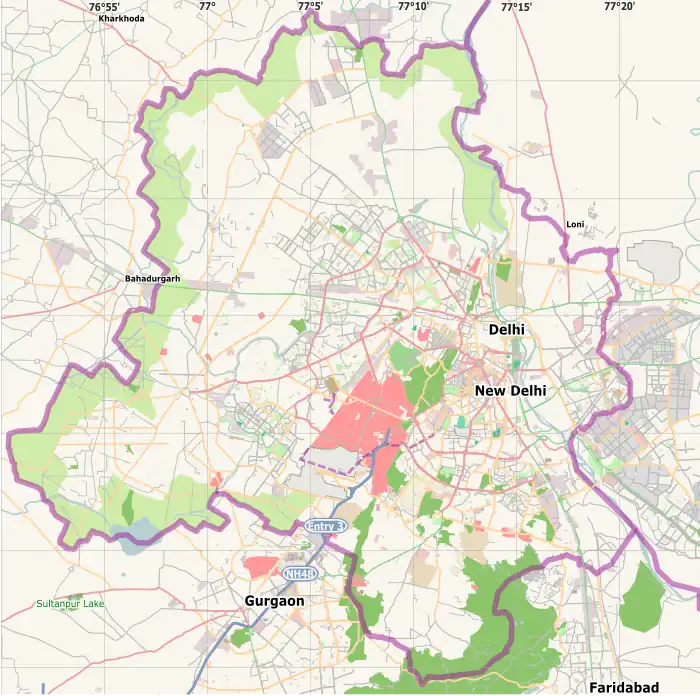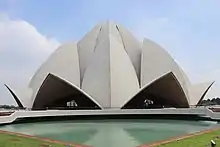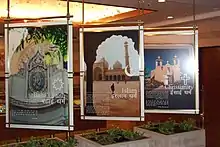Lotus Temple
The Lotus Temple, located in New Delhi, India, is a Baháʼí House of Worship that was dedicated in December 1986. Notable for its lotus-like shape, it has become a prominent attraction in the city. Like all Bahá’í Houses of Worship, the Lotus Temple is open to all, regardless of religion or any other qualification. The building is composed of 27 free-standing marble-clad "petals" arranged in clusters of three to form nine sides,[1] with nine doors opening onto a central hall with a height of slightly over 34 meters[1] and a capacity of 1,300 people.[2] The Lotus Temple has won numerous architectural awards[3][4] and has been featured in many newspaper and magazine articles.[5]
| Lotus Temple (Baháʼí House of Worship) | |
|---|---|
 Full view of the Lotus Temple | |
 Location within New Delhi | |
| General information | |
| Type | House of Worship |
| Architectural style | Expressionist |
| Location | Delhi, India |
| Coordinates | 28.553328°N 77.258456°E |
| Completed | 13 November 1986 |
| Opened | 24 December 1986 |
| Height | 34.27 metres (112.4 ft) |
| Dimensions | |
| Diameter | 70 metres (230 ft) |
| Technical details | |
| Structural system | Concrete frame and precast concrete ribbed roof |
| Design and construction | |
| Architect(s) | Fariborz Sahba |
| Structural engineer | Flint & Neill COWI |
| Other information | |
| Seating capacity | 2,500 |
History
The architect of the Lotus Temple was an Iranian, Fariborz Sahba who now lives in La Jolla, California,[6] after spending some years in Canada.[7] He was approached in 1976 to design the Lotus Temple and later oversaw its construction. The structural design was undertaken by the UK firm Flint and Neill over the course of 18 months,[8] and the construction was done by ECC Construction Group of Larsen & Toubro Limited[9] at a cost of $10.56 million.[10][11] The major part of the funds needed to buy this land was donated by Ardishír Rustampúr of Hyderabad, Sindh (Pakistan), whose will dictated that his entire life savings would go toward the building of the temple.[12] A portion of the construction budget was saved and used to build a greenhouse to study indigenous plants and flowers that would be appropriate for use on the site.[13]
Rúhíyyih Khánum laid the foundation stone for the Lotus Temple on 19 October 1977 and dedicated the temple on 24 December 1986.[14] For the dedication, there was a gathering of 8,000 Baháʼís from 107 countries, including some 4,000 Baháʼís from 22 provinces in India. The temple was opened to the public on 1 January 1987 and more than 10,000 people visited that day.[15]
Worship
The Baháʼí Faith teaches that a Baháʼí House of Worship should be a space for people of all religions to gather, reflect, and worship.[16] Anyone may enter the Lotus Temple irrespective of religious background, gender, or other distinctions, as is the case with all Baháʼí Houses of Worship.[16] The sacred writings of not only the Baháʼí Faith but also other religions can be read and/or chanted, regardless of language;[16] on the other hand, reading nonscriptural texts is forbidden, as are delivering sermons or lectures, or fundraising. Musical renditions of readings and prayers can be sung by choirs, but no musical instruments can be played inside. There is no set pattern for worship services, and ritualistic ceremonies are not permitted.[16]
Structure

.JPG.webp)
All Baháʼí Houses of Worship, including the Lotus Temple, share certain architectural elements, some of which are specified by Baháʼí scripture. ʻAbdu'l-Bahá, the son of the founder of the religion, wrote that Baháʼí Houses of Worship must be nine-sided and circular.[16] While all current Baháʼí Houses of Worship have a dome, this is not regarded as an essential part of their architecture.[14] Baháʼí scripture also states that no pictures, statues or images be displayed within the House of Worship, and no pulpits or altars be incorporated as an architectural feature (readers may stand behind simple portable lecture stands).[16]
Inspired by the lotus flower, the design for the House of Worship in New Delhi is composed of 27 free-standing marble-clad "petals" arranged in clusters of three to form nine sides.[17] The temple's shape has symbolic and inter-religious significance because the lotus is often associated with purity, sacredness, spirituality, and knowledge. It has a spiritual significance in India.[3] The nine doors of the Lotus Temple open onto a central hall 34.3 meters tall[1] that can seat 1,300 people[18] and hold up to 2,500 in all.[2] The temple has a diameter of 70 m.[19] The surface of the House of Worship is made of white marble from Penteli mountain in Greece, the same marble used in the construction of many ancient monuments (including the Parthenon[18]) and other Baháʼí buildings.[20] Along with its nine surrounding ponds and gardens, the Lotus Temple property comprises 26 acres (105,000 m2; 10.5 ha).[4] An educational centre beside the temple was established in 2017.[21]
The Lotus Temple is situated near Okhla NSIC and Kalkaji Mandir metro station is just 500 meters away. It is in the village of Bahapur in New Delhi, National Capital Territory of Delhi, near Nehru Place.[22]
Of the temple's total electricity use of 500 kilowatts (kW), 120 kW is provided by solar power generated by solar panels on the building.[23] This saves the temple ₹120,000 per month.[23] It is the first temple in Delhi to use solar power.[24]
As is the case with other stone monuments such as the Taj Mahal, the Lotus Temple is becoming discoloured due to air pollution in India. Specifically, the white marble is turning grey and yellow due to pollution from vehicles and manufacturing in the city, among other sources.[25]
Visitors
By late 2001, The Lotus Temple had attracted more than 70 million visitors, according to Manpreet Brar, a CNN reporter.[26] The permanent delegation of India to UNESCO stated that the Lotus Temple had received over 100 million visitors by April 2014.[18]
The Lotus Temple has become a major attraction for people of various religions, with up to 100,000 visitors on some holidays.[3] Estimates for the number of visitors annually range from 2.5 million to 5 million.[3][17][21] Brar stated in 2001 that it was the "most visited building in the world".[26] The Lotus Temple is often listed as one of Delhi's main tourist attractions.[17]
Distinctions

The Temple has received a wide range of attention in professional architectural, fine art, religious, governmental, and other venues.
Awards
- 1987, the architect of the Baháʼí House of Worship, Fariborz Sahba, was presented the award for excellence in religious art and architecture by the UK-based Institution of Structural Engineers for producing a building "so emulating the beauty of a flower and so striking in its visual impact".[27]
- 1987, the Interfaith Forum on Religion, Art and Architecture, Affiliate of the American Institute of Architects, Washington, D.C., gave their First Honour award for "Excellence in Religious Art and Architecture" 1987 to Fariborz Sahba for the design of the Baháʼí House of Worship near New Delhi.[8]
- 1988, the Illuminating Engineering Society of North America conferred the Paul Waterbury Special Citation for Outdoor Lighting for the "Taj Mahal of the Twentieth Century"[22]
- 1989, the Temple received an award from the Maharashtra-India Chapter of the American Concrete Institute for "excellence in a concrete structure".[8]
- 1994 edition of Encyclopædia Britannica, in its "Architecture" section gives recognition to the Temple as an outstanding achievement of the time.[8]
- 2000, Architectural Society of China as one of 100 canonical works of the 20th century[17] in "World Architecture 1900-2000: A Critical Mosaic, Volume Eight, South Asia".[5]
- 2000, GlobArt Academy, based in Vienna, Austria, presented its "GlobArt Academy 2000" award to the architect of the Lotus Temple, Fariborz Sahba, for "the magnitude of the service of [this] Taj Mahal of the 20th century in promoting the unity and harmony of people of all nations, religions and social strata, to an extent unsurpassed by any other architectural monument worldwide."[5][17]
Publications


Articles
By 2003, the Baháʼí World Centre Library had archived more than 500 publications which carried information on the Lotus Temple in the form of articles, interviews with the architect and write-ups extolling the structure.[8] The following are major examples of publications featuring articles on the temple listed chronologically, and excerpted quotations:
- Progressive Architecture, February 1987[8] and December 1987
- Architecture, September 1987[8]
- Structural Engineer (annual UK journal), December 1987[8]
- Encyclopaedia Iranica, 1989[8]
- World Architecture: A Critical Mosaic 1900-2000, by Kenneth Frampton, Vol 8, 2000[28] - "A power icon of great beauty ... an import symbol of the city."
- Actualité des Religions (French magazine), Fall 2000 special edition entitled "Les religions et leurs chef-d'œuvres" (Religions and their Masterpieces), four-page article[8][29]
- Guinness World Records, 2001[28]
- Wallpaper*, October 2002
- Lighting Design + Application Vol 19, No. 6, Illuminating Engineering Society of North America - "Taj Mahal of the Twentieth Century"
- Faith & Form (journal of the Interfaith Forum on Religion, Art and Architecture, an affiliate of the American Institute of Architects), Vol XXI - "An extraordinary feat of design, construction, and appropriateness of expressions"
- BBC Travel, 2016, The world's most beautiful places of worship
Arrests
In 2006, some former employees of the Lotus Temple made a complaint to the police that the trustees of the temple had been involved in various crimes including spying, religious conversion and producing false passports. The trial judge directed the police to arrest nine specific trustees, but the Delhi High Court later stayed the arrests.[30][31]
Gallery
 The Baháʼí House of Worship in Delhi at night
The Baháʼí House of Worship in Delhi at night People outside the Lotus Temple
People outside the Lotus Temple Model of the temple at the information centre
Model of the temple at the information centre Full view of the Lotus Temple
Full view of the Lotus Temple The Lotus Temple with trees in front
The Lotus Temple with trees in front Some of the displays about the Baháʼí teaching of the unity of religion at the entrance of the information centre
Some of the displays about the Baháʼí teaching of the unity of religion at the entrance of the information centre Greenery in front of the temple
Greenery in front of the temple The Lotus Temple at sunset
The Lotus Temple at sunset Drone shot of The Lotus Temple, 2023
Drone shot of The Lotus Temple, 2023
See also
- Swaminarayan Akshardham (Delhi)
- Baháʼí Faith in India
- Baháʼí World Centre buildings
- Prayer in the Baháʼí Faith
- Other modern structures with similar designs:
Notes
- National Spiritual Assembly of the Baháʼís of India 2003.
- Galloway 2016.
- Garlington 2006.
- Rizor 2011.
- Baháʼí World News Service 2000.
- Mackin-Solomon 2013.
- National Spiritual Assembly of the Baháʼís of Canada 2003.
- Baháʼí Association at The University of Georgia 2003.
- Naharoy 2011.
- Warburg 1993.
- Smith 2000, p. 241.
- Faizi 1993.
- Recreating Eden 2006.
- Momen 2010.
- Satpathy 2019.
- Rafati & Sahba 1988.
- Hassall 2012.
- Permanent Delegation of India to UNESCO 2014.
- Warburg 2006, p. 488.
- Dionyssos Marbles 2010.
- Pearson 2022.
- Buck 2010.
- The Hindu 2015.
- Sharma 2015.
- Kaur 2022.
- Brar 2001.
- Sarwal n.d.
- National Spiritual Assembly of the Baháʼís of India n.d.
- The Architecture of Fariborz Sahba n.d.. Click "Publications".
- webindia123.com 2006.
- The Hindu 2006.
References
Books
- Faizi, Gloria (1993). Stories about Baháʼí Funds. New Delhi, India: Baháʼí Publishing Trust. ISBN 81-85091-76-5.
- Garlington, William (2006). "Indian Baha'i tradition". In Mittal, Sushil; Thursby, Gene R. (eds.). Religions of South Asia. London: Routledge. pp. 247–260. ISBN 0415223903.
- Hassall, Graham (2012). "The Bahá'í House of Worship: Localisation and Universal Form". In Cusack, Carol; Norman, Alex (eds.). Handbook of New Religions and Cultural Production. Brill Handbooks on Contemporary Religion. Vol. 4. Leiden: Brill. pp. 599–632. doi:10.1163/9789004226487_025. ISBN 978-90-04-22187-1. ISSN 1874-6691.
- Pearson, Anne M. (2022). "Ch. 49: South Asia". In Stockman, Robert H. (ed.). The World of the Bahá'í Faith. Oxfordshire, UK: Routledge. pp. 603–613. doi:10.4324/9780429027772-56. ISBN 978-1-138-36772-2. S2CID 244701542.
- Warburg, Margit (2006). Citizens of the World: A History and Sociology of the Bahaʹis from a Globalisation Perspective. Brill. ISBN 978-90-04-14373-9.
Encyclopedias
- Buck, Christopher (2010). "Temples—Baha'i Faith". In Melton, J. Gordon; Baumann, Martin (eds.). Religions of the World: A Comprehensive Encyclopedia of Beliefs and Practices. Vol. 6. Santa Barbara, California: ABC-CLIO. pp. 2817–2821. Retrieved 1 December 2021.
- Momen, Moojan (2010). "Mašreq al-Aḏkār". Encyclopædia Iranica (online ed.).
- Rafati, V.; Sahba, F. (1988). "BAHAISM ix. Bahai Temples". In Yarshater, Ehsan (ed.). Encyclopaedia Iranica. Vol. 3 (Online ed.). New York. pp. 465–467. Retrieved 24 December 2016.
{{cite encyclopedia}}: CS1 maint: location missing publisher (link) - Smith, Peter (2000). A Concise Encyclopedia of the Baháʼí Faith. Oneworld Publications, Oxford, England. ISBN 1-85168-184-1.
News media
- "Baha'i Temple in India continues to receive awards and recognitions". Baháʼí World News Service. 5 December 2000. Retrieved 21 December 2020.
- Brar, Manpreet (14 July 2001). "Encore Presentation: A Visit to the Capital of India: New Delhi". CNN. Archived from the original on 29 April 2019. Retrieved 12 October 2022.
- Galloway, Lindsey (3 January 2016). "The world's most beautiful places of worship". BBC Travel. BBC. Retrieved 18 June 2016.
- Mackin-Solomon, Ashley (23 January 2013). "Iranian architect living in La Jolla devoted to creating 'spiritual space'". La Jolla Light. Retrieved 27 November 2021.
- Sarwal, Anil. "An Architectural Marvel". The Tribune. Chandigarh. Archived from the original on 28 September 2008. Retrieved 25 April 2016 – via Baha'is of India.
- Satpathy, Kriti Saraswat (18 December 2019). "5 Interesting Facts About Bahai Lotus Temple in Delhi That You Must Know!". India.com. Retrieved 9 March 2021.
- Sharma, Sameer (20 October 2015). "Baha'i House of Worship -Lotus Temple is on Solar Energy now". Ohindore.com. Archived from the original on 30 May 2016. Retrieved 18 June 2016.
- "High Court stays arrest of Lotus temple trustees". The Hindu. 22 March 2012 [19 August 2006]. Retrieved 22 September 2017.
- Staff reporter (20 October 2015). "Solar power for Lotus temple". The Hindu. Retrieved 13 October 2022.
- "HC stays arrest of Lotus temple trustees". webindia123.com. 18 August 2006. Retrieved 22 September 2017.
- "Historical Places in Delhi". 10 November 2022. Retrieved 15 November 2022.
Other
- "Architecture of the Baháʼí House of Worship". National Spiritual Assembly of the Baháʼís of India. 2020. Retrieved 14 December 2020.
- "Baháʼí Houses of Worship, India: The Lotus of Bahapur". Baháʼí Association at The University of Georgia. 9 February 2003. Archived from the original on 7 May 2016. Retrieved 12 April 2016.
- "Bibliography of Publications". Baháʼí Faith: The Official Website of the Baháʼís of India. National Spiritual Assembly of the Baháʼís of India. Archived from the original on 21 December 2016. Retrieved 10 December 2016.
- "Fariborz Sahba". National Spiritual Assembly of the Baháʼís of Canada. 2003. Archived from the original on 27 October 2004. Retrieved 19 January 2014.
- Kaur, Pushpinder (2022). "Legal Regime for the Protection of Heritage Stone Monuments in India: a Study with Special Reference to Taj Mahal and Lotus Temple". Geoheritage. 14 (3): 87. doi:10.1007/s12371-022-00721-9. S2CID 250361171.
- Naharoy, S. (3 September 2011). "The Baha'i House of Worship" (PDF). ECC Concord (Special Edition, Lotus in Concrete (v2, reprint) ed.). Cerena de Souza: 3–4. Retrieved 6 June 2014.
- "Penteli marbles for Bahai temples". Dionyssos Marbles. 2010. Archived from the original on 26 July 2010.
- Permanent Delegation of India to UNESCO (15 April 2014). "Baháʼí House of Worship at New Delhi". UNESCO World Heritage Convention. United Nations Educational, Scientific and Cultural Organization. Retrieved 21 December 2020.
- ""Gardens of Worship"". "Recreating Eden". Season 03. Episode 30. 2006. Archived from the original on 1 March 2012.
- Rizor, John (21 August 2011). "AD Classics: Lotus Temple / Fariborz Sahba". ArchDaily. Retrieved 27 November 2021.
- "Articles". The Architecture of Fariborz Sahba. Archived from the original on 13 January 2006. Retrieved 25 April 2016.
- Warburg, Margit (1993). "Economic Rituals: The Structure and Meaning of Donations in the Baha'i Religion". Social Compass. 40 (1): 25–31. doi:10.1177/003776893040001004. S2CID 144837705.
Further reading
- "In the shadow of the lotus, peace and calm prevail". Baháʼí World News Service. Baháʼí International Community. 19 March 2008. Retrieved 3 November 2020.
- Naharoy, S. Architectural Blossoming of the Lotus
- Bahá'í News, June 1986, special issue about the Lotus Temple
